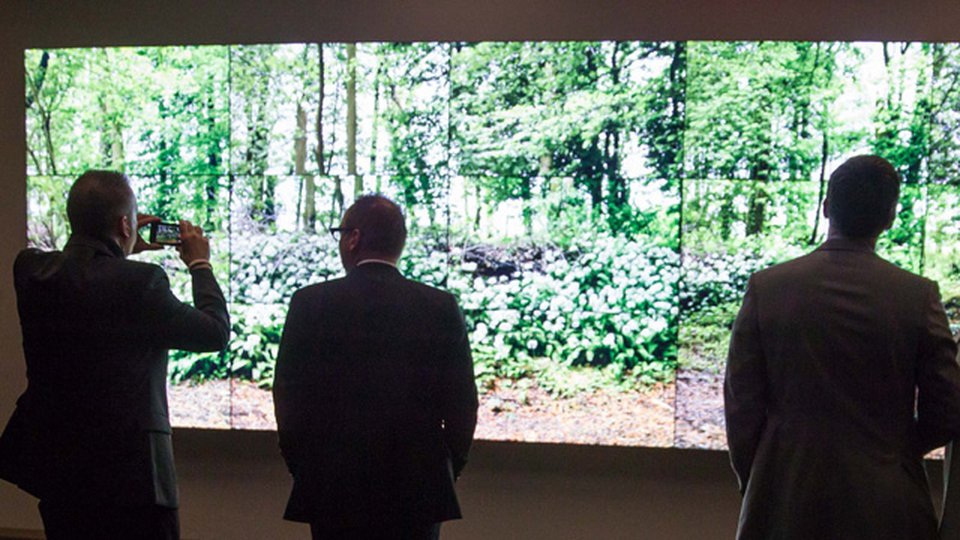Article
Digital signage making a case for its own night at the museum
Several recent digital signage deployments show how the technology is bringing exhibits to life in museums around the world.

September 12, 2014 by Christopher Hall — w, t
Either as part of the display or as a way of better explaining displays and engaging with visitors, digital signage is making inroads as a key element for the modern museum and for curating the museum-going experience.
Whether as video walls displaying the work of an artist who rose to fame in the 1960s, or as interactive wall plaques elucidating the history of a U.S. president, digital signage can take many forms in the museum:
Sometimes, the medium is part of the work. A recent retrospective of famed British artist David Hockney at San Francisco's de Young Museum embraced digital signage as part of an exhibit dedicated to showing how the artist has "embraced new technologies throughout his career — everything from Polaroid cameras to fax machines — shifting between media as his own style evolves," according to a case study from digital signage provider NEC Display Solutions of America.
The museum showcased an expansive collection of Hockney's work, "David Hockney: A Bigger Exhibition," with a focus on his recent video art and drawings composed on iPads. As part of the exhibit, several massive NEC video walls featuring the technology-enabled work served as a dramatic centerpiece amid conventional paintings and drawings.
"All told, this array forms an in-depth portrait of the artist as a tradition-fluent progressive working nonstop at the height of his powers, deftly juggling digital and analog modes of representation and energetically pursuing newness on several fronts," New York Times art critic Roberta Smith wrote in her review of the show.

As part of an art exhibition, the displays obviously had to present images with accurate color and sharpness, in variable lighting conditions — and without failing.
"We've used other screens in the past that have stopped working in the middle of a show," said Rich Rice, the de Young's audio-visual manager, in the case study. "It's a lot of money when you're working with a lot of screens, but using something that's commercial-grade is important."
One video wall featured footage of a wooded area near Hockney's home, filmed with a digital video camera during each of the four seasons. Another followed jugglers moving across a stage – and across several screens. Some of the digital video paintings would be displayed as a static image, while others showed the actual painting process, stroke by stroke.
The result was "one of the most popular exhibits ever to run" at the museum, Rice said in the case study.
"The show was very well-received, and word got around," he said. "Even people who typically do not go to art museums were awestruck by the large digital images. That doesn't always happen. It was a fantastic, grand show."
After the show's end, the largest of the Hockney installations was set to remain at the de Young through October 2014, possibly to become a permanent exhibit. The museum has repurposed the rest of the displays for other uses, according to NEC, including signage for visitors and as a four-by-four video wall in the exhibition offices that curators use to examine floor plans for upcoming projects.
But the technology isn't just making inroads in the art world.Digital signage recently helped upgrade the visitor experience at the Penn State University All-Sports Museum in University Park, Pennsylvania.
The All-Sports Museum "upholds the Penn State Ideals of honor, tradition and pride by paying tribute to 34 current and former varsity sports," according to a case study on the project from digital signage kiosk software provider Livewire Digital.
As part of a recent upgrade to the museum's facilities, Livewire worked with Marketechs Design Studio, which designed and assembled the kiosks, determined where the new kiosks would be placed, removed the old kiosks and installed the new ones. Marketechs partnered with Livewire Digital for the application programming. Both companies are run by Penn State alumni "who were thrilled to be involved with this project," according to the case study.
Now the museum features interactive digital signage kiosks displaying searchable information about nearby exhibits.
The new kiosks' content management system "allows us to store a vast variety of data in one place as well as make all the information searchable by the public," Museum Director Ken Hickman said in the case study. "Each touchscreen kiosk allows museum visitors to call up information on all Penn State sports, such as year-by-year schedules, team records and information about university athletes that took part in the Olympics."

Presidential history has also gotten the digital signage treatment. The William McKinley Presidential Library and Museum in Canton, Ohio, has installed digital signage throughout the facility, according to an announcement from Videotel Inc., which provided digital signage media players for the project.
"The … interactive solution in our Street of Shops has been very well-received and enjoyed by our visitors," Museum Director Joyce Yut said of the technology that has been installed throughout the museum for visitors to use and interact with. "Guests have the opportunity to select various content with a press of a push button."
And digital signage also is making its case for replacing static information plaques in museums as well. Ljubljana, Slovenia-based Visionect recently set up a temporary display in a museum using e-paper digital signage tablets as live, interactive information plaques. The company ran the display as a test case, and has not yet been cleared to release the name of the museum, but has written up the results as a testament to the effectiveness of digital signage.
Rather than the standard, static information plaques used in many museums to accompany exhibits, Visionect said, it implemented its Web-connected V-Tablets as interactive wall-mounted digital displays. Not only do the displays make the experience more engaging for museum goers, but they also provide museum operators with detailed and real-time analytic feedback on visitors' activity, the company said.
According to the Visionect blog, "[m]useums often contemplate how to make their exhibitions more engaging and interesting to its visitors, and how to attract those that do not visit these institutions frequently. To do this, museums need to solve two main issues. They need a way of providing a better interactive experience, and means of catering to the different needs of the visitors."
Deploying interactive digital signage that better engages visitors and caters to their specific interests is one way to solve, or at least minimize, those problems, the company said.
"Our deployment in the museum was temporary -- as a short term case study proving that the concept works," Visonect CTO Luka Birsa said in an email. "The feedback was phenomenal and they decided to cover a part of their collection with [the] digital signage system."

Cover image and top image courtesy of the de Young Museum, credit: Randy Dodson.
Middle image courtey of Livewire Digital.
Bottom image courtesy of Visionect.







